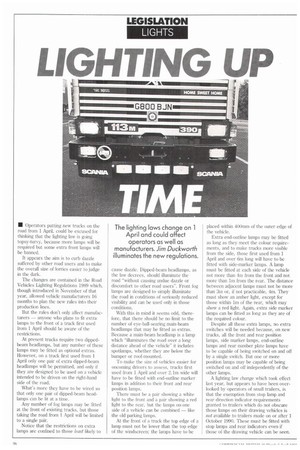LIGHTING UP
Page 28

If you've noticed an error in this article please click here to report it so we can fix it.
• Operators putting new trucks on the road from 1 April, could be excused for thinking that the lighting law is going topsy-turvy, because more lamps will be required but some extra front lamps will be banned.
It appears the aim is to curb dazzle suffered by other road users and to make the overall size of lorries easier to judge in the dark.
The changes are contained in the Road Vehicles Lighting Regulations 1989 which, though introduced in November of that year, allowed vehicle manufacturers 16 months to plan the new rules into their production lines.
But the rules don't only affect manufacturers — anyone who plans to fit extra lamps to the front of a truck first used from 1 April should be aware of the restrictions.
At present trucks require two dippedbeam headlamps, but any number of these lamps may be fitted as optional extras. However, on a truck first used from 1 April only one pair of extra dipped-beam headlamps will be permitted, and only if they are designed to be used on a vehicle intended to be driven on the right-hand side of the road.
What's more they have to be wired so that only one pair of dipped-beam headlamps can be lit at a time.
Any number of fog lamps may be fitted at the front of existing trucks, but those taking the road from 1 April will be limited to a single pair.
Notice that the restrictions on extra lamps are confined to those least likely to cause dazzle. Dipped-beam headlamps, as the law decrees, should illuminate the road "without causing undue dazzle or discomfort to other road users". Front fog lamps are designed to simply illuminate the road in conditions of seriously reduced visibility and can be used only in those conditions.
With this in mind it seems odd, therefore, that there should be no limit to the number of eye-ball-searing main-beam headlamps that may be fitted as extras. Because a main-beam headlamp is a lamp which "illuminates the road over a long distance ahead of the vehicle" it includes spot lamps, whether they are below the bumper or roof-mounted.
To make the size of vehicles easier for oncoming drivers to assess, trucks first used from 1 April and over 2.1m wide will have to be fitted with end-outline marker lamps in addition to their front and rear position lamps.
There must be a pair showing a white light to the front and a pair showing a red light to the rear, but the lamps on one side of a vehicle can be combined — like the old parking lamps.
At the front of a truck the top edge of a lamp must not be lower than the top edge of the windscreen; the lamps have to be placed within 400mm of the outer edge of the vehicle.
Extra end-outline lamps may be fitted as long as they meet the colour requirements, and to make trucks more visible from the side, those first used from 1 April and over 6rn long will have to be fitted with side-marker lamps. A lamp must be fitted at each side of the vehicle not more than 4m from the front and not more than lm from the rear. The distance between adjacent lamps must not be more than 3m or, if not practicable, 4m. They must show an amber light, except for those within lm of the rear, which may show a red light. Again, extra side marker lamps can be fitted as long as they are of the required colour.
Despite all these extra lamps, no extra switches will be needed because, on new trucks, all the front and rear position lamps, side marker lamps, end-outline lamps and rear number plate lamps have to be capable of being switched on and off by a single switch. But one or more position lamps may be capable of being switched on and off independently of the other lamps.
A lighting law change which took effect last year, but appears to have been overlooked by operators of small trailers, is that the exemption from stop lamp and rear direction indicator requirements granted to trailers which do not obscure those lamps on their drawing vehicles is not available to trailers made on or after 1 October 1990. These must be fitted with stop lamps and rear indicators even if those of the drawing vehicle can be seen.
















































































